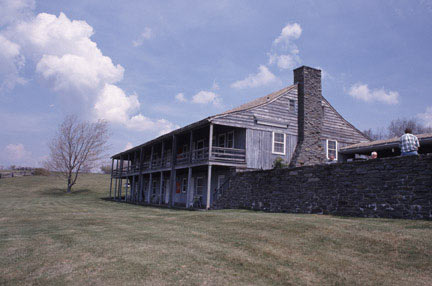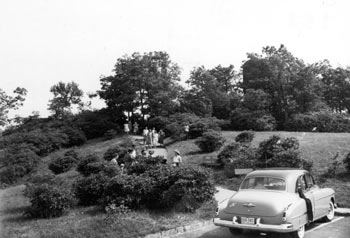The Blue Ridge Parkway winds through the mountains of Virginia and North Carolina, offering motorists recreational and scenic opportunities. The Bluffs Lodge landscape, part of Doughton Park, was one of the first developed areas planned for the parkway. The lodge, overlook, and other features of the site reflect the rustic style of park design, and contemporary visitors can still experience the site's historic character.

NPS
Bluffs Lodge is a 24‑acre landscape set within 6300‑acre Doughton Park, a Blue Ridge Parkway developed area in North Carolina. The lodge is located off the parkway at Milepost 241.1. A road leads off the parkway, passes by the lodge, and terminates in a parking lot for Wildcat Rocks Overlook. The landscape includes the roadway, the lodge, Wildcat Rocks Overlook, and the nearby water tower.
Bluffs Lodge is part of one of the first developed areas that was planned for the Blue Ridge Parkway. The entry road, Wildcat Rocks Overlook, and its parking lot were built in 1938‑9. The lodge was built about ten years later, opening on September 1, 1949.
Bluffs Lodge is part of one of the first developed areas that was planned for the Blue Ridge Parkway. The entry road, Wildcat Rocks Overlook, and its parking lot were built in 1938‑9. The lodge was built about ten years later, opening on September 1, 1949.
The overlook is a prime example of the rustic‑style stonework used in the early years of parkway construction. The lodge is also rustic in style, but uses materials such as concrete shingles that were important in post‑WWII parkway development. It also represents the overall transition from cabin‑style accommodations to the current motel style.
The features of the open meadow, with its rolling topography and scattering of trees, rhododendron, mountain laurel, and azaleas, are distinctive among parkway landscapes. The natural setting figured prominently in the siting of the lodge and associated development. Significant views from this area include the perspective over Basin Cove from the overlook and into the meadow from the lodge.

NPS
The Blue Ridge Parkway is historically significant for the years between 1933 and 1987, representing the period of parkway road development. Construction at Bluffs Lodge began in 1938, and all major features at the property were in place by the installation of the Robert L. Doughton memorial plaque in 1953. All these features contribute to the national significance of Blue Ridge Parkway as a National Historic Landmark property.

NPS
All major features from this period of significance remain on the Bluffs Lodge landscape. Bluffs Lodge is part of one of the first developed areas to be designed and built along the Blue Ridge Parkway. Two buildings exist at the property: the lodge, completed in 1949, and the pump house, completed circa 1948‑1952. The entry road was completed by 1939, along with Wildcat Rocks Overlook and its parking lot and walkway. The final major addition to the site is the Robert L. Doughton Memorial Plaque, which was installed in 1953 at the start of the walkway leading from the parking lot to the overlook.
The rolling mountain laurel and rhododendron meadows, interspersed with patches of forest, figured prominently in selecting this location for the lodge. A 1942 planting plan called for the enhancement of this existing flora, with a few trees suggested for the entry. Today, visitors along the Blue Ridge Parkway still stop at the lodge and enjoy the spectacular views from Wildcat Rocks Overlook.
Quick Facts
- Cultural Landscape Type: Designed
- National Register Significance Level: National
- National Register Significance Critera: A, C
- Period of Significance: 1933-1987
Landscape Links
Part of a series of articles titled Cultural Landscapes of Blue Ridge Parkway: Doughton Park.
Last updated: December 31, 2020
